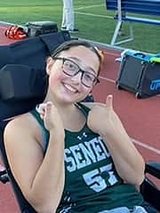Acetabular retroversion: Hannah’s story
Acetabular retroversion: Hannah’s story
Not only does the term “acetabular retroversion” roll off her tongue now with impressive ease, 15-year-old Hannah says hearing the unfamiliar diagnosis for her painful hip condition two years ago didn’t scare her – thanks to the expert and compassionate care she received at Children’s Hospital of Philadelphia (CHOP).

“I don’t think I was scared because Dr. Sankar did such a good job explaining it,” Hannah says of Wudbhav N. Sankar, MD, an orthopedic surgeon who heads up CHOP’s Hip Disorders Program and is Director of the Young Adult Hip Preservation Program.
Dr. Sankar is a nationally recognized leader in diagnosing and treating all types of hip conditions, with a special focus on complex disorders that require precision surgical repairs. He was also the doctor who correctly diagnosed her condition and worked with her family to find the best treatment for the young teen.
Unexplained pain in the hip
Looking back, Hannah says she began to feel intermittent discomfort in her right hip when she was about 12 years old. In most cases, the pain followed a competitive game of field hockey – her passion since fourth grade.
Hannah’s pediatrician suspected iliotibial band syndrome, which occurs when a tendon becomes irritated or swollen from rubbing against the hip or knee bones. She’d likely outgrow it, the doctor advised.
For the next two years, Hannah endured occasional discomfort, but generally got relief by resting her hip after active days. The discomfort was more annoying than painful to Hannah, but not cause for major concern – until New Year’s Day 2020.
In the early morning hours, Hannah, then 13, was awakened by excruciating pain radiating from her hip. She screamed and cried out for her parents. “I couldn’t move. It hurt so bad,” Hannah recalls. “On a scale of one to 10, it was higher than a 10.”
Hannah’s mother drove her to an urgent care center near their home in Southampton, NJ. After an examination discovered no obvious source for her pain, medical personnel advised: “if the pain gets worse, go to a pediatric ER,” Elizabeth says.
The family was puzzled. Hannah’s pain had never been so intense, and when there was discomfort, it typically followed an athletic activity. In this case, Hannah had spent the night before playing board games, not exerting herself in any way.
CHOP provides answers for teen hip pain

By dinner, Hannah was still in agonizing pain. Elizabeth decided to take her daughter directly to Children’s Hospital of Philadelphia (CHOP) – bypassing other facilities closer to home – to ensure her daughter had access to every possible resource to figure out what was wrong.
At CHOP’s Emergency Department, Hannah was examined, and X-rays performed. That’s when the family first learned the true nature of Hannah’s hip problem. She had acetabular retroversion, a form of hip dysplasia where the hip socket is tilted backwards, resulting in too much socket in the front of the joint, and too little in the back.
Hannah was offered over-the-counter medication for the pain and encouraged to follow up with an orthopedic specialist. Soon after, she met with Dr. Sankar, who explained her condition in more detail and recommended physical therapy as a first-step treatment.
Over the next three months, Hannah attended physical therapy (PT) sessions with Meredith Link, DPT, PT, ATC, and later, Casey Huse, DPT, PT, at CHOP Specialty Care, Virtua. While PT improved Hannah’s stiffness, it did not alleviate her pain.
Seeking another non-surgical treatment to try, Dr. Sankar referred Hannah to his colleague, Naomi Brown, MD, FAAP, CAQSM, a pediatric sports medicine specialist. Dr. Brown prescribed a series of steroid injections to dull the pain and improve Hannah’s hip function, but unfortunately in Hannah’s case, the results were short-lived.
Surgery to reorient the hip socket

When Hannah met with Dr. Sankar again, it was time to discuss the possibility of surgery. Dr. Sankar recommended a periacetabular osteotomy (PAO), a complex and highly specialized procedure that involves cutting and reorientating the hip socket (acetabulum) to provide better coverage over the ball (femoral head) of the thigh bone (femur). Hannah and her parents agreed surgery was the best option and felt confident in Dr. Sankar’s ability to treat her hip disorder.
On Nov. 2, 2021, Hannah underwent a successful periacetabular osteotomy and was discharged after a brief hospital stay. Though she had limited mobility for the first few weeks’ post-op, Hannah says she appreciated the fact that her clinical team had prepared her before surgery by teaching her how to walk on crutches, to navigate steps and how get to the bathroom by herself.
Soon after, she was able to resume schoolwork from home and she never fell behind in her studies. Six weeks later, she was cleared to start putting weights on her leg and has experienced steady improvement in her mobility, pain and mood since then.
‘Best decision of my life’
By July 2022, Hannah was stronger than ever. Hannah resumed her place as goalie on her field hockey team. Now that her pain is gone and her mobility has increased, she’s excited to begin her junior year of high school and start visiting colleges. She hopes to become a history professor, with an emphasis on the Holocaust. Her 84-year-old grandfather, who hid from the Nazis as a child, is her inspiration.
“Before, everything was a concern for Hannah,” says her mother. “Now, anything is possible. We can’t thank CHOP enough for the phenomenal care they gave to Hannah.”
Adds Hannah:
“ Having surgery at CHOP was the best decision of my life. ”